City in Florida, United States
| Marianna, Florida | |
|---|---|
| City | |
| City of Marianna | |
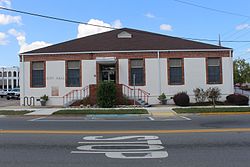 Marianna City Hall Marianna City Hall | |
| Nickname: The City of Southern Charm | |
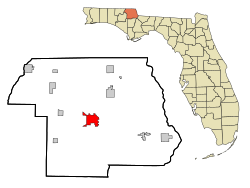 Location in Jackson County and the state of Florida Location in Jackson County and the state of Florida | |
| Coordinates: 30°46′35″N 85°14′17″W / 30.77639°N 85.23806°W / 30.77639; -85.23806 | |
| Country | |
| State | |
| County | Jackson |
| Incorporated | 1825 |
| Government | |
| • Type | Commission–Manager |
| • Mayor | John Roberts |
| • Commissioners | Allen Ward, Rico Williams, Travis Ephriam, and Kenneth Hamilton |
| • City Manager | William H. Long |
| • City Clerk | Kimberly Applewhite |
| • City Attorney | Matt Fuqua |
| Area | |
| • Total | 18.65 sq mi (48.29 km) |
| • Land | 18.60 sq mi (48.17 km) |
| • Water | 0.05 sq mi (0.12 km) |
| Elevation | 167 ft (51 m) |
| Population | |
| • Total | 6,245 |
| • Density | 335.75/sq mi (129.63/km) |
| Time zone | UTC-6 (Central (CST)) |
| • Summer (DST) | UTC-5 (CDT) |
| ZIP codes | 32446-32448 |
| Area code | 850 |
| FIPS code | 12-43175 |
| GNIS feature ID | 0286422 |
| Website | www |
Marianna is a city in and the county seat of Jackson County, Florida, United States, and it is home to Chipola College. The official nickname of Marianna is "The City of Southern Charm". The population was 6,245 at the 2020 census.
History

Marianna was founded in 1828 by Scottish entrepreneur Scott Beverege, who named the town after his daughters Mary and Anna. The following year, it was designated as the county seat, superseding the earlier settlement of Webbville, which soon after dissolved and no longer exists. Marianna was platted along the Chipola River. Many planters from North Carolina relocated to Jackson County to develop new plantations to take advantage of the fertile soil. They relied on the labor of enslaved African Americans brought from the Upper South in the domestic slave trade.
Civil War era
Governor John Milton, a major planter who owned the Sylvania Plantation and hundreds of slaves, was a grandson of Revolutionary War hero John Millton, and a descendant of Sir Christopher Milton, the brother of the famous English poet, John Milton. However, Milton did not have to rely solely on a distinguished American founding family name. A Marianna resident, he was elected as governor of Florida, serving during the Civil War years. Governor Milton opposed the Confederate States of America rejoining the United States.
As federal troops were preparing to take control of Tallahassee, Governor Milton received word that the Civil War had ended and that Florida would again be part of the United States. On April 1, 1865, as the Southern cause was collapsing, Milton died of a gunshot wound from his gun at Sylvania. A New York Times article, written in polemic style, attributed Governor Milton's sudden death to suicide, which conflicted with local reporting from Florida. The Governor's words, likely political oratorical hyperbole, that he "would rather die" than suffer the humiliation of Federal invasion, were linked to his sudden death by the New York Times. The West Florida News reported the sudden death of Florida's fifth Governor as a hunting accident. Governor Milton was buried in the St. Luke's Episcopal churchyard at Marianna. The New York Times article's account persisted in the difficult days of Reconstruction.
Marianna was the site of a Civil War battle in 1864 between a small home guard of about 150 boys, older men, and wounded soldiers, and a contingent of approximately 700 Federal troops.
Reconstruction period
During the early years after the Civil War, violence flared in Marianna and Jackson County, where 150 to 200 Republicans, some black, were assassinated in what was known as the Jackson County War by members of the Ku Klux Klan in an effort to secure white supremacy. Locals claimed this was the work of "ruffians" from border states and carpetbaggers. Bishop Charles H. Pearce of Massachusetts, an AME minister who became a state senator in Florida, had first-hand knowledge of the situation. He placed the blame on the planters of Jackson County, who supported action against black Republicans. Disputes over farm land caused much of the disorder, as poor whites objected to negro ownership of choice farms.

Post-Reconstruction to mid-20th century
Violence continued in the state after Reconstruction, reaching a peak in most areas at the turn of the 20th century. This was the period in which southern states also disenfranchised most blacks and thousands of poor whites by raising barriers to voter registration. From 1900 to 1930, Florida had the highest rate of lynchings per capita in the South and the nation. Refusing to accept the violence, thousands of African Americans left the state during the Great Migration of the early 20th century, going to northern and midwestern industrial cities for work and other opportunities.
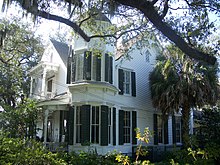
Lynchings in Marianna
In 1934 Claude Neal, a local African-American man, was accused of the rape and murder of a young white woman. He was moved between jails, but a lynch mob found him in Brewton, Alabama. The mob abducted him and brought him back to Florida, killing him near the Chattahoochee River and Greenwood. The men brought his body to the Cannady farm, where a larger mob of an estimated 2,000 persons was waiting; people shot and mutilated the body. Neal's body was hanged from a tree at the Marianna courthouse square. The next day, whites rioted in town, attacking blacks and destroying some of their houses. The governor ordered more than 100 troops of the National Guard to Marianna to suppress the violence. About 200 blacks and two police were injured. The six white vigilantes who led the lynching remain unidentified.

In 1943 Cellos Harrison was taken from the county jail at Marianna by a white mob and hanged (lynched) near Greenwood. His case had been in the courts for two years in appeals after the African-American man was arrested and twice convicted by all-white juries and sentenced to death for the 1940 murder of a white man. He had confessed without benefit of counsel, and his convictions were overturned by the Florida Supreme Court as a result. But whites were tired of waiting for the case to be resolved, and lynched him. President Franklin D. Roosevelt directed the Department of Justice to investigate Harrison's lynching; he felt it was unjust that blacks were getting lynched at home while the U.S. was ostensibly fighting for freedom in Europe. No one was ever prosecuted for Harrison's death.
Florida School for Boys
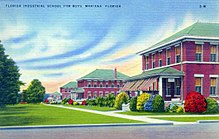
The Florida School for Boys, a large state reform school, operated in Marianna from January 1, 1900, to June 30, 2011. For a time, it was the largest juvenile reform institution in the United States. Throughout its 111-year history, the school gained a reputation for abuse, beatings, rapes, and torture of students by staff. It was rumored that students had died there as a result of injuries. Despite periodic investigations, changes of leadership, and promises by the state to improve conditions, the allegations of cruelty and abuse continued.
Many of the allegations were confirmed by separate investigations by the Florida Department of Law Enforcement in 2010 and the Civil Rights Division of the United States Department of Justice in 2011. State authorities closed the school permanently in June 2011. In 2015, a multi-year investigation of the cemetery and grounds by the University of South Florida (USF), which was attempting to find undocumented burials on the grounds, revealed details of a secret "rape dungeon", where boys younger than 12 were sexually abused. It positively identified five bodies from remains recovered on the grounds. By January 2016, the end of the USF's studies of the grounds and exhumation of remains, it had identified 55 previously unknown burials, made a match for seven bodies through DNA, and presumptively identified another 14 sets of remains of 51 found. Twenty-seven more graves were discovered in 2019. The team created a website containing documentation of their investigation and will continue to work with state agencies and families of former students to identify more remains.
Hurricane Michael
The city was one of several Florida Panhandle communities devastated by Category 5 Hurricane Michael on October 10, 2018. The downtown area was heavily hit, with several historic buildings collapsing and blocking Lafayette Street, which is the main road. The city was without power for three weeks, which caused extensive school cancellations. More than 80% of homes and businesses in Marianna were heavily damaged or destroyed due to Michael's extreme winds. Millions of dollars in insurance claims were filed and the area also suffered millions of dollars in economic losses. This hurricane is the worst natural disaster to ever strike Marianna, surpassing the damages caused by a F-3 tornado spawned by Hurricane Ivan in September 2004.
Geography
Marianna is located in central Jackson County at 30°46′35″N 85°14′17″W / 30.77639°N 85.23806°W / 30.77639; -85.23806 (30.776370, –85.238149). U.S. Route 90 passes through the center of town as Lafayette Street, leading east 14 miles (23 km) to Grand Ridge and west 9 miles (14 km) to Cottondale. Interstate 10 passes through the southern end of the city, leading east 65 miles (105 km) to Tallahassee, the state capital, and west 130 miles (210 km) to Pensacola. Access to Marianna is at Exit 136, Florida State Road 276.
According to the United States Census Bureau, the city has a total area of 16.8 square miles (43.6 km), of which 0.04 square miles (0.1 km), or 0.29%, are water. The Chipola River, which forms the eastern border of the city, is part of the Apalachicola River watershed.
Climate
| Climate data for Marianna, Florida (Marianna Municipal Airport), 1991–2020 normals, extremes 1950–present | |||||||||||||
|---|---|---|---|---|---|---|---|---|---|---|---|---|---|
| Month | Jan | Feb | Mar | Apr | May | Jun | Jul | Aug | Sep | Oct | Nov | Dec | Year |
| Record high °F (°C) | 84 (29) |
87 (31) |
89 (32) |
94 (34) |
101 (38) |
105 (41) |
105 (41) |
104 (40) |
103 (39) |
99 (37) |
89 (32) |
85 (29) |
105 (41) |
| Mean maximum °F (°C) | 78.3 (25.7) |
80.3 (26.8) |
85.5 (29.7) |
89.3 (31.8) |
95.6 (35.3) |
97.8 (36.6) |
98.3 (36.8) |
97.7 (36.5) |
95.8 (35.4) |
91.0 (32.8) |
84.0 (28.9) |
79.6 (26.4) |
99.7 (37.6) |
| Mean daily maximum °F (°C) | 62.9 (17.2) |
67.1 (19.5) |
73.7 (23.2) |
80.1 (26.7) |
87.5 (30.8) |
91.2 (32.9) |
92.4 (33.6) |
91.4 (33.0) |
88.7 (31.5) |
81.1 (27.3) |
71.7 (22.1) |
64.7 (18.2) |
79.4 (26.3) |
| Daily mean °F (°C) | 51.8 (11.0) |
55.4 (13.0) |
61.5 (16.4) |
67.6 (19.8) |
75.9 (24.4) |
81.1 (27.3) |
82.7 (28.2) |
82.1 (27.8) |
78.7 (25.9) |
69.5 (20.8) |
59.6 (15.3) |
53.9 (12.2) |
68.3 (20.2) |
| Mean daily minimum °F (°C) | 40.7 (4.8) |
43.8 (6.6) |
49.2 (9.6) |
55.1 (12.8) |
64.2 (17.9) |
71.1 (21.7) |
73.0 (22.8) |
72.8 (22.7) |
68.6 (20.3) |
58.0 (14.4) |
47.4 (8.6) |
43.0 (6.1) |
57.2 (14.0) |
| Mean minimum °F (°C) | 23.1 (−4.9) |
28.0 (−2.2) |
32.0 (0.0) |
40.4 (4.7) |
50.7 (10.4) |
63.8 (17.7) |
68.6 (20.3) |
66.9 (19.4) |
56.8 (13.8) |
42.0 (5.6) |
30.5 (−0.8) |
27.2 (−2.7) |
22.0 (−5.6) |
| Record low °F (°C) | 16 (−9) |
16 (−9) |
23 (−5) |
33 (1) |
45 (7) |
55 (13) |
62 (17) |
61 (16) |
46 (8) |
28 (−2) |
20 (−7) |
17 (−8) |
16 (−9) |
| Average precipitation inches (mm) | 4.04 (103) |
4.49 (114) |
5.01 (127) |
3.72 (94) |
3.15 (80) |
5.07 (129) |
5.10 (130) |
4.93 (125) |
4.06 (103) |
3.06 (78) |
3.67 (93) |
4.81 (122) |
51.11 (1,298) |
| Average precipitation days (≥ 0.01 in) | 10.0 | 9.4 | 9.0 | 7.4 | 6.4 | 12.4 | 13.9 | 13.6 | 9.4 | 8.1 | 8.9 | 10.7 | 119.2 |
| Source: XMACIS2 | |||||||||||||
Demographics
| Census | Pop. | Note | %± |
|---|---|---|---|
| 1850 | 377 | — | |
| 1860 | 440 | 16.7% | |
| 1870 | 663 | 50.7% | |
| 1880 | 586 | −11.6% | |
| 1890 | 926 | 58.0% | |
| 1900 | 900 | −2.8% | |
| 1910 | 1,915 | 112.8% | |
| 1920 | 2,499 | 30.5% | |
| 1930 | 3,372 | 34.9% | |
| 1940 | 5,079 | 50.6% | |
| 1950 | 5,845 | 15.1% | |
| 1960 | 7,152 | 22.4% | |
| 1970 | 7,282 | 1.8% | |
| 1980 | 7,006 | −3.8% | |
| 1990 | 6,292 | −10.2% | |
| 2000 | 6,230 | −1.0% | |
| 2010 | 6,102 | −2.1% | |
| 2020 | 6,245 | 2.3% | |
| U.S. Decennial Census | |||
Marianna first appeared in the 1850 U.S. Census with a recorded population of 377.
2010 and 2020 census
| Race | Pop 2010 | Pop 2020 | % 2010 | % 2020 |
|---|---|---|---|---|
| White (NH) | 3,173 | 3,026 | 52.00% | 48.45% |
| Black or African American (NH) | 2,540 | 2,500 | 41.63% | 40.03% |
| Native American or Alaska Native (NH) | 23 | 18 | 0.38% | 0.29% |
| Asian (NH) | 56 | 115 | 0.92% | 1.84% |
| Pacific Islander or Native Hawaiian (NH) | 4 | 6 | 0.07% | 0.10% |
| Some other race (NH) | 5 | 23 | 0.08% | 0.37% |
| Two or more races/Multiracial (NH) | 136 | 262 | 2.23% | 4.20% |
| Hispanic or Latino (any race) | 165 | 295 | 2.70% | 4.72% |
| Total | 6,102 | 6,245 |
As of the 2020 United States census, there were 6,245 people, 2,908 households, and 1,662 families residing in the city.
As of the 2010 United States census, there were 6,102 people, 1,924 households, and 1,189 families residing in the city.
2000 census
As of the census of 2000, there were 6,230 people, 2,398 households, and 1,395 families residing in the city. The population density was 776.1 inhabitants per square mile (299.7/km). There were 2,764 housing units at an average density of 344.3 per square mile (132.9/km). The racial makeup of the city was 56.8% White, 40.2% African American, 0.3% Native American, 0.7% Asian, 0.9% from other races, and 1.1% from two or more races. Hispanic or Latino of any race were 2.6% of the population.
In 2000, there were 2,398 households, out of which 28.8% had children under the age of 18 living with them, 34.3% were married couples living together, 20.7% had a female householder with no husband present, and 41.8% were non-families. 38.0% of all households were made up of individuals, and 19.3% had someone living alone who was 65 years of age or older. The average household size was 2.22 and the average family size was 2.96.
In 2000, in the city, the population was spread out, with 26.7% under the age of 18, 11.8% from 18 to 24, 22.3% from 25 to 44, 18.4% from 45 to 64, and 20.8% who were 65 years of age or older. The median age was 36 years. For every 100 females, there were 88.9 males. For every 100 females age 18 and over, there were 76.7 males.
In 2000, the median income for a household in the city was $23,861, and the median income for a family was $29,590. Males had a median income of $28,500 versus $21,530 for females. The per capita income for the city was $14,021. About 20.9% of families and 28.5% of the population were below the poverty line, including 41.7% of those under age 18 and 34.6% of those age 65 or over.
Education
Jackson County School Board operates public K–12 schools. Marianna has four schools, all of which usually perform in the high C-low B range in the state's FCAT grade scale. Marianna K-8 School for grades Pre-K to 8th grade, and Marianna High School for grades 9–12, Jackson Alternative School for grades 4-12, and Hope School for grades PK-12.
Chipola College, home of the Chipola Indians, is the choice for many residents and offers dual-enrollment classes for high school students. The college is a four-year state institution offering bachelor's degrees in nine programs. Additionally, students can earn masters and doctoral degrees on the Chipola Campus through Troy State University, University of Florida, University of West Florida, and Florida State University.

From 1961 to 1966, a junior college, Jackson Junior College, served African-American students. It closed in 1966 after passage of the Civil Rights Act of 1964 and the opening of Chipola Junior College (today Chipola College) to all students.
Transportation
Highways
Railroads
Freight service is provided by the Florida Gulf & Atlantic Railroad, which acquired most of the former CSX main line from Pensacola to Jacksonville on June 1, 2019.
Airports
Marianna Municipal Airport was developed at a former World War II Army Air Corps base that was transferred to the city. It is a public-use airport located 4 miles (6.4 km) northeast of the central business district.
Attractions
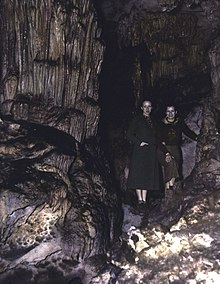
Marianna is an official Florida Main Street town. The downtown area has been restored to look as it did many years ago, to encourage heritage tourism and emphasize its unique character and a pedestrian-friendly neighborhood. The downtown area includes the Marianna Historic District, which has a number of antebellum homes.
Florida Caverns State Park is located 2 miles (3 km) north of town. There is also cave diving in underwater Blue Springs. St. Luke's Episcopal Church and cemetery are state landmarks, as they had a principal role in the U.S. Civil War battle of Marianna in 1864.
The Chipola River is a source of recreation during all but the winter months.
Notable people
- Kelly J. Baker, writer and editor
- Tim Davis, former pitcher for the Seattle Mariners
- Cliff Ellis, basketball head coach, Coastal Carolina University, born in Marianna
- Timothy Thomas Fortune, civil rights leader, writer, born in Marianna
- Bobby Goldsboro, pop and country singer-songwriter, born in Marianna
- Alex Hamilton (born 1993), basketball player for Hapoel Eilat in the Israeli Basketball Premier League
- David Hart, actor, TV series In the Heat of the Night
- George Sydney Hawkins, politician and justice
- Caroline Lee Hentz, novelist and author
- Danny Lipford, home improvement expert
- Moss Mabry, Academy Award-nominated costume designer
- Jeff Mathis, professional baseball player
- John Milton, governor of Florida during the Civil War
- William Hall Milton, U.S. senator
- Claude Neal, African-American victim of torture and spectacle lynching in 1934 after being accused of rape
- Sam E. Parish, 8th Chief Master Sergeant of the Air Force
- Rick Pearson, professional golfer
- Pete Peterson, American politician and diplomat
- Wankard Pooser, politician
- Edd Sorenson, professional cave diver
- Jim Sorey, professional football player
- Ret Turner, Emmy Award-winning costume designer
- Doug Woodlief, professional football player
Gallery
-
 St. Luke Baptist Church
St. Luke Baptist Church
-
St. Luke's Episcopal Church
-
 Joseph W. Russ, Jr. House
Joseph W. Russ, Jr. House
-
 Ely-Criglar Plantation House
Ely-Criglar Plantation House
References
- "2020 U.S. Gazetteer Files". United States Census Bureau. Retrieved October 31, 2021.
- ^ "U.S. Census website". United States Census Bureau. Retrieved January 31, 2008.
- "US Board on Geographic Names". United States Geological Survey. October 25, 2007. Retrieved January 31, 2008.
- "Find a County". National Association of Counties. Retrieved June 7, 2011.
- ^ Federal Writers' Project (1939). Florida. A Guide to the Southernmost State. New York: Oxford University Press.
- "Suicide of Gov. Milton, of Florida". The New York Times. May 1, 1865. ISSN 0362-4331. Retrieved January 13, 2019.
- Cox, Dale (2010). The History of Jackson County, Florida: The Civil War Years. Two Egg, FL: CreateSpace Independent Publishing Platform. p. 191. ISBN 978-1448685141.
- Wasserman, Adam (2010). A People's History of Florida 1513–1876. How Africans, Seminoles, Women, and Lower Class Whites Shaped the Sunshine State (4th ed.). Sarasota, Florida. ISBN 9781442167094.
{{cite book}}: CS1 maint: location missing publisher (link) - Tameka Bradley Hobbs, Democracy Abroad, Lynching at Home: Racial Violence in Florida, Oxford University Press, 2015
- Luscombe, Richard (February 6, 2015). "'Rape Dungeon' Allegations Emerge in Abuse Report on Dozier School for Boys". The Guardian. Retrieved February 7, 2015.
- Stofan, Jake (April 11, 2019). "Additional 27 suspected graves identified at Dozier School for Boys". WJXT (news4jax).
- Osbourne, Heather (October 19, 2018). "HURRICANE MICHAEL: Cottondale, Marianna pick up pieces". Northwest Florida Daily News. Retrieved January 30, 2019.
- "US Gazetteer files: 2010, 2000, and 1990". United States Census Bureau. February 12, 2011. Retrieved April 23, 2011.
- "2016 U.S. Gazetteer Files". United States Census Bureau. Retrieved July 7, 2017.
- "xmACIS2". National Oceanic and Atmospheric Administration. Retrieved March 5, 2023.
- "Summary of Monthly Normals 1991–2020". National Oceanic and Atmospheric Administration. Retrieved June 25, 2021.
- "Census of Population and Housing". Census.gov. Retrieved June 4, 2015.
- "1850 Census of Population: Florida" (PDF). Retrieved March 31, 2023.
- "P2 HISPANIC OR LATINO, AND NOT HISPANIC OR LATINO BY RACE - 2010: DEC Redistricting Data (PL 94-171) - Marianna city, Florida". United States Census Bureau.
- "P2 HISPANIC OR LATINO, AND NOT HISPANIC OR LATINO BY RACE - 2020: DEC Redistricting Data (PL 94-171) - Marianna city, Florida". United States Census Bureau.
- "S1101 HOUSEHOLDS AND FAMILIES - 2020: Marianna city, Florida". United States Census Bureau.
- "S1101 HOUSEHOLDS AND FAMILIES - 2010: Marianna city, Florida". United States Census Bureau.
- Walter L. Smith, The Magnificent Twelve: Florida's Black Junior Colleges, Winter Park, Florida, FOUR-G Publishers, 1994, ISBN 1885066015, pp. 211-225.
- Whitburn, Joel (1996). The Billboard Book of Top 40 Country Hits, pp.128–29. ISBN 0-8230-7632-6.
External links
| Marianna, Florida | |||||||
|---|---|---|---|---|---|---|---|
| Areas | |||||||
| Education |
| ||||||
| Transportation | |||||||
| Government |
| ||||||
| Landmarks | |||||||
| This list is incomplete. | |||||||
| Municipalities and communities of Jackson County, Florida, United States | ||
|---|---|---|
| County seat: Marianna | ||
| Cities |  | |
| Towns | ||
| Unincorporated communities | ||
| Ghost town | ||